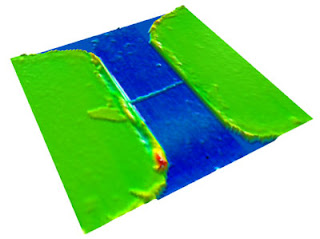
3D image of a device based on aligned CNT networks. The image shows two electrodes (wide green regions) connected by a 100nm-wide channel comprised of aligned CNT networks (thin green line) on the SiO2 substrate (wide blue regions).
"We found that we can improve the transistor behavior and mobility of CNT network films simply by aligning CNTs in the network films, which effectively enhances their serial connectivity" Seunghun Hong, an associate professor of physics at Seoul National University, tells Nanowerk. "For example, we can achieve a mobility as large as 180 cm2/Vs by aligning CNTs in 100nm wide channels. Using this strategy, we significantly improved the yield of SWCNT network-based FETs with a large on–off ratio without removing metallic SWCNTs"
Hong and his team have reported their findings in a recent paper in Small ("'Textured' Network Devices: Overcoming Fundamental Limitations of Nanotube/Nanowire Network-Based Devices").
"We could fabricate high-performance FETs with high yield of about 88% using textured network channels while maintaining high current level," Hong explains. "Significantly, both experiments and simulations showed that the textured network channels enhance conductivity and mobility with reduced line width, which is a completely opposite behavior to randomly oriented SWCNT networks or even conventional silicon-based devices. It indicates that this strategy can be an ultimate solution to solve the fundamental limitations for scaling down nanoelectronic devices."
Schematic diagram depicting the fabrication procedure of FETs based on random or textured SWCNT network channels.
The basic procedure to prepare devices with random or textured SWCNT network channels is similar to that reported by Hong and collaborators previously in Nature Nanotechnology ("Linker-free directed assembly of high-performance integrated devices based on nanotubes and nanowires"): They patterned a self-assembled monolayer with non-polar terminal groups onto a silicon dioxide surface using photolithography or e-beam lithography. When the substrate was placed in the SWCNT suspension, the nanotubes were selectively adsorbed onto bare silicon dioxide regions up to a full monolayer (since SWCNTs show strong affinity to most bare surfaces – for example, gold, silicon dioxide, glass, silicon and aluminum – this affinity can be used as a means to direct SWCNT assembly).
Hong and his colleagues are now working on applying their method using purified CNTs with uniform properties, which should allow them to mass-produce uniform arrays of high-performance CNT network-based devices. Actually, they have developed high-performance sensors based on this strategy but the manuscript on these findings,including the results, are currently under review.

No comments:
Post a Comment